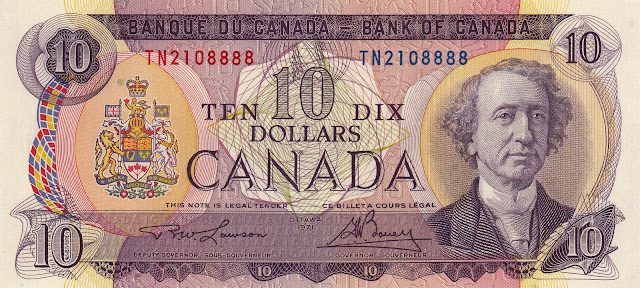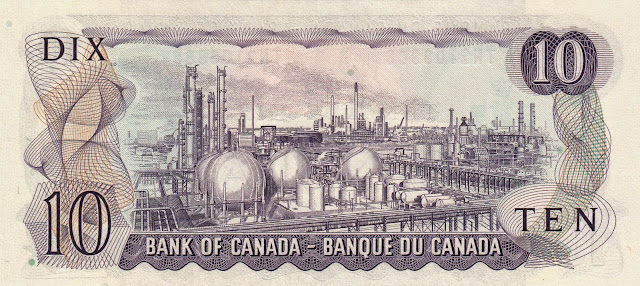Canadian Banknotes 10 Dollar Note 1971 Sir John A. Macdonald
Bank of Canada - Banque du Canada
Obverse: Portrait of Sir John Alexander Macdonald (1815 – 1891), was the first Prime Minister of Canada (1867–1873, 1878–1891), the engraving was created by Gunderson. Arms of Her Majesty The Queen in Right of Canada at left. The engraving on banknote made from the lithography of Sir John Alexander Macdonald, made by Rolph Smith Ltd, Toronto, from the Photo by Notman & Fraser.
Signatures: Governor of the Bank of Canada (Gouverneur) - Gerald Bouey; Deputy Governor of the Bank of Canada (Sous-Gouverneur) - R. William Lawson.
Reverse: Polymer Corporation oil refinery in Sarnia, Ontario.
A scene depicting the operations of Polymer Corporation in Sarnia, Ontario is on the reverse, chosen because the Crown corporation had "achieved a world-wide reputation" and the image "provided detail ideally suited to engraving", according to a Bank of Canada memorandum. The engraving was made by De La Rue based on a photograph taken by Hunter. In a Toronto Star article in 1990, Christopher Hume stated that the image of the petrochemical plant on the reverse was the most notable example of the dismal scenes of the series.
The $10 banknote was first circulated in November 1971, and was printed by Canadian Bank Note Company Limited, Ottawa.
Canada banknotes - Canada paper money
Scenes of Canada, 1969-1979 Series
Scenes of Canada was the fourth series of banknotes of the Canadian dollar issued by the Bank of Canada. It was first circulated in 1970 to succeed the 1954 Series, and was replaced by the Birds of Canada series beginning in 1986.The design process for this series began in 1963 with a primary goal of creating banknotes that were more counterfeit-resistant than the 1954 Series it was to replace.
Each denomination retained the dominant colour of the respective banknote from the 1954 Series: green for the $1 banknote, orange (terracotta) for the $2 banknote, blue for the $5 banknote, mauve (purple) for the $10 banknote, burnt orange (red) for the $50 banknote, and brown for the $100 banknote. Because of the multicoloured tints used to complement the design for each banknote, Bank of Canada staff began referring to the series as the "multicoloured series".
Initially, all denominations were to feature the portrait of Elizabeth II, but portraits of former prime ministers were used for some denominations at the request of Edgar Benson, the Minister of Finance in 1968, to "reflect Canada's burgeoning national identity". The vertical borders of the obverse were curvilinear, the left edge of which had "multicoloured diamonds" bordering a circular frame within which was the Coat of Arms. It also featured "sweeping guilloché" patterns.
One Dollar 2 Dollars 5 Dollars 10 Dollars
Polymer Corporation
Polymer Corporation was a Canadian federal crown corporation established in 1942 to produce artificial rubber to substitute for overseas supply cut off by World War II. A factory was established in Sarnia, Ontario where, using German patents from an American licensee, Polymer produced 5000 tons of artificial rubber from oil every month. The product was used in everything from tires to airplane parts and much of it was sold to the US as part of the common war effort.
The company was considered a roaring success, more efficient than its American counterparts and a national asset. Clarence Decatur Howe, under whose Department of Munitions and Supply the company fell, decided to keep Polymer going as a Crown corporation after the war. It was a highly profitable enterprise, and he was not convinced that any buyer would pay a proper price or keep it going. Polymer therefore survived the war, reporting through Howe and his successors to Parliament until 1971 when it was sold to the Canada Development Corporation which was a government controlled enterprise. The company was also involved in the petrochemicals industry, primarily in the production of polyurethane. It was renamed Polysar in 1976 and the rubber component became a subsidiary, Polysar Rubber Corp.
The company was privatized in 1988 with its sale to NOVA Corp which, in turn, sold Polysar Rubber in 1990 to Bayer AG of Germany. The original Sarnia production facilities were shut down through a series of closures from 1995 through 2002, but the site remains active, operating facilities built through expansion beginning in the 1980s. In 2005 Bayer AG spun off chemical divisions, including most of the Sarnia site, creating LANXESS AG, also of Germany.
Polymer's contribution was recognized by the 1971 Canadian ten-dollar note of the Scenes of Canada series, which depicted a scene of its operations on the reverse. The image was used because the company had "achieved a world-wide reputation" and the image "provided detail ideally suited to engraving".
It has been cited as an example of how crown corporations can be profitable over a sustained period of time and contribute to the economy.
Canadian 10 Dollar Bills
Canadian 10 Dollar Bill 1954 Queen Elizabeth II Canadian 10 Dollar Bill 1971 Sir John A. Macdonald
Canadian 10 Dollar Bill 1989 Sir John A. Macdonald Canadian 10 Dollar Bill 2005 Sir John A. Macdonald

